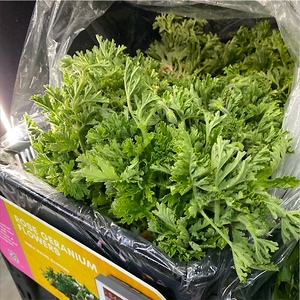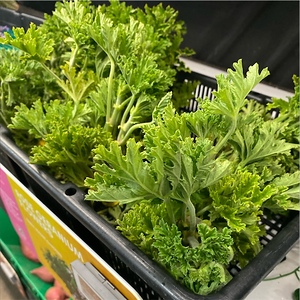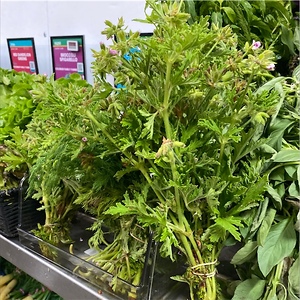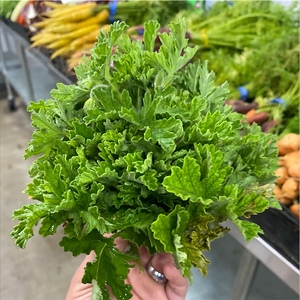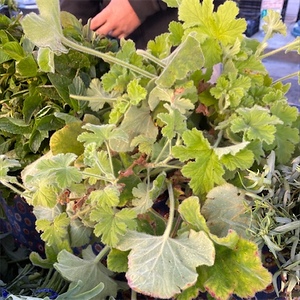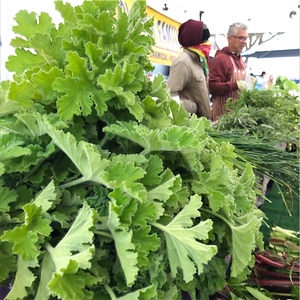


Rose Geranium Leaves
Estimated Inventory, bunch : 19.00
This item was last sold on : 06/20/25
Description/Taste
Rose geranium is an upright shrub that can reach anywhere from 30 to 90 centimeters tall and spread up to 60 centimeters wide. The leaves will vary in color, shape, and texture depending upon the variety. However, most common Rose geranium varieties tend to have thicker, tri-lobed green leaves with a somewhat velvety texture and distinctly curled edges. The small, sweet-smelling flowers may range from white to shades of pink or lavender. As their name implies, Rose geranium leaves emit a strong, aromatic rose-like scent with subtle notes of citrus, spice, and green herbs, and they offer a delicate, rose-like, floral yet herby flavor.
Seasons/Availability
Rose geranium leaves are available year-round.
Current Facts
Rose geraniums, or Rose-scented geraniums, are members of the Geraniaceae, or geranium family, but despite their common name, they are not actually “true” geraniums. Though they share the same plant family, true geraniums are hardy North American and European plants belonging to the genus, Geranium, while the tender “scented geraniums” are classified under the genus Pelargonium. Scented geraniums were once part of the Geranium genus, but even after they were separated into their Pelargonium genus in 1789, their common name and subsequent confusion persevered. There are a couple hundred distinct varieties of scented geraniums that are categorized by their aromas, which range from nutmeg to lemon, and chocolate and peppermint. Even within the category of Rose-scented geraniums, there are dozens of unique varieties, such as Rober's Lemon Rose, said to have the sweetest scent and flavor, and Attar of Roses often touted as the best of the Rose-scented geraniums. Rose geranium leaves are known for their fragrant essential oils and have been used for centuries to make perfumes and natural pest repellents, as well as dried and used in sachets and potpourri.
Nutritional Value
Rose geranium leaves are believed to have antiseptic, anti-inflammatory, antifungal, antiviral, and astringent properties and have long been used in herbal medicine, aromatherapy, soaps, and cosmetics. In the traditional medicine of their native land of Africa, they have been used to treat intestinal complaints, wounds, respiratory ailments, fevers, and more. In aromatherapy, their fragrant essential oil is used for its balancing effect, helping to reduce stress, anxiety, and fatigue and even ease insomnia. It is also often used for facial steams as it is said to have anti-aging benefits for the skin.
Applications
Rose geranium leaves are most commonly used to infuse their sweet, perfumy, rose-like flavor into sugar, butter, cream, simple syrups, and jellies. Infused sugar can easily be made by mixing fresh Rose geranium leaves with sugar in a sealed jar and storing them in a warm or sunny location for a couple of weeks. The infused sugar can then be used for baked goods, whipped cream, or to sweeten and flavor tea. Fresh leaves can also be added to fruit dishes and beverages like iced tea and lemonade or steeped in cream and then added to custards, pudding, or ice cream. Their floral flavor pairs exceptionally well with berries and lime. Store Rose geranium leaves in the refrigerator for up to two weeks.
Ethnic/Cultural Info
Rose geranium plants have been cultivated in France and Africa since the 1700s for their oil, and they became particularly popular during the Victorian era in England because of their use as a deodorant and perfume. Essential oils from the leaves were added to bathwater and other hygiene products as a means of masking body odor, and it was soon discovered that the variety known as Attar of Roses served seamlessly as a substitute for the more costly rose oil, derived from rose petals. Plantations of Attar of Roses and other rose-scented geraniums were founded by British landowners in Kenya, and greenhouses were established across England. This continued until World War I, when fuel shortages led to a ban on greenhouse production for ornamental plants. Cultivation of Rose geraniums tailored off, and it wasn’t until after World War II that they revitalized their popularity. Today, Rose geranium leaves are still used to produce perfumes and synthetic rose oil.
Geography/History
Rose geraniums originated in South Africa and were introduced to Europeans in the early 1600s. By the mid-1600s, the Dutch East India Company had established trade with South Africa for the plants, which were taken to Holland and bred for specific qualities. The colonists brought Rose geraniums with them to the Americas, and even Thomas Jefferson became a fan of the sweet-smelling plant, as he was known to grow them in the White House gardens. Rose geraniums are tender, frost-sensitive perennials grown in home gardens in Africa, Europe, Australia, and North America. Note that, if left outdoors, they will rarely survive the winter throughout most of the United States, but they are also well-suited for growing in containers, which makes them easier to move inside and ensure they receive enough sunlight. Rose geranium leaves can be found at local markets and specialty stores.
Featured Restaurants
Restaurants currently purchasing this product as an ingredient for their menu.
| Paradisaea Restaurant | La Jolla CA | 732-915-6669 |
Recipe Ideas
Recipes that include Rose Geranium Leaves. One
| The Bojon Gourmet |
|
Tayberry, Rose Geranium + Buttermilk Popsicles |



